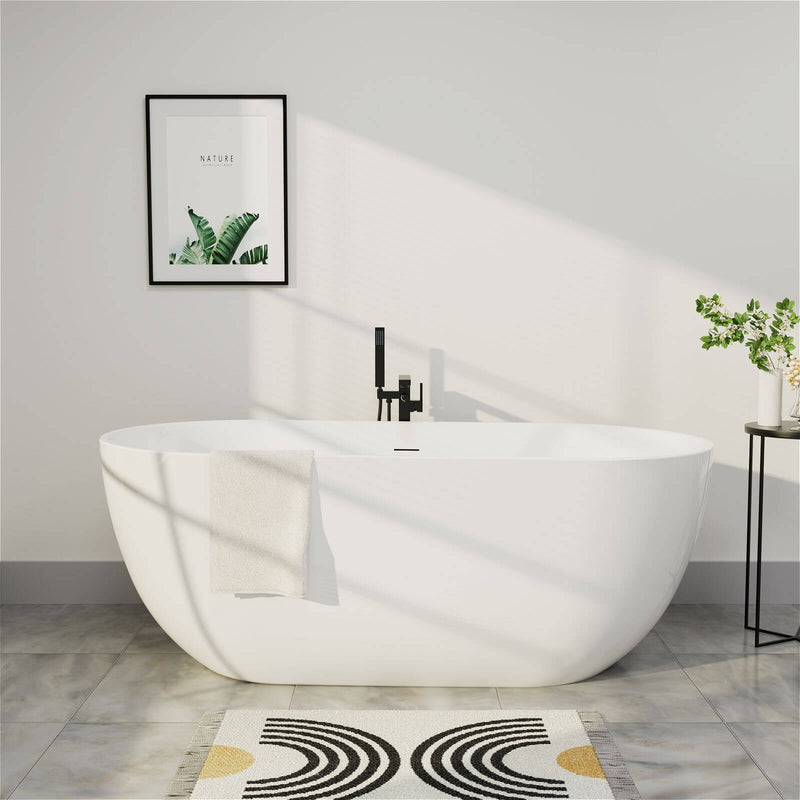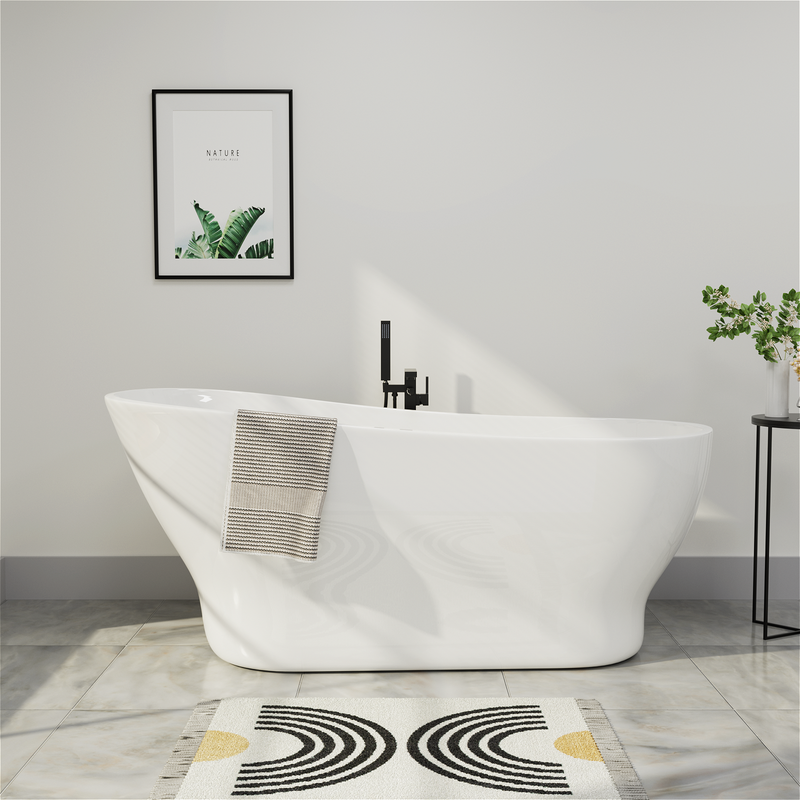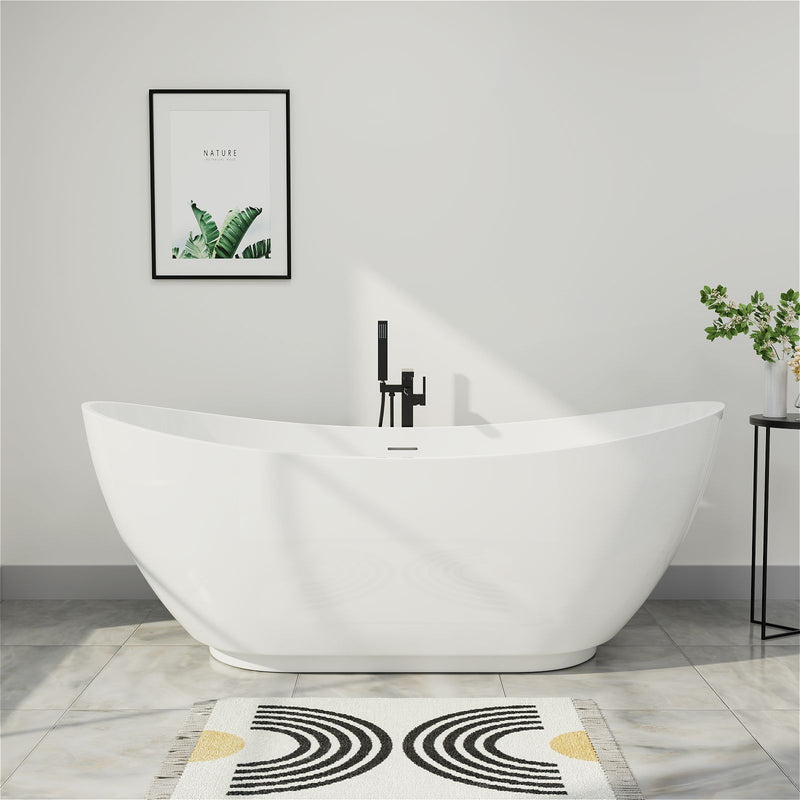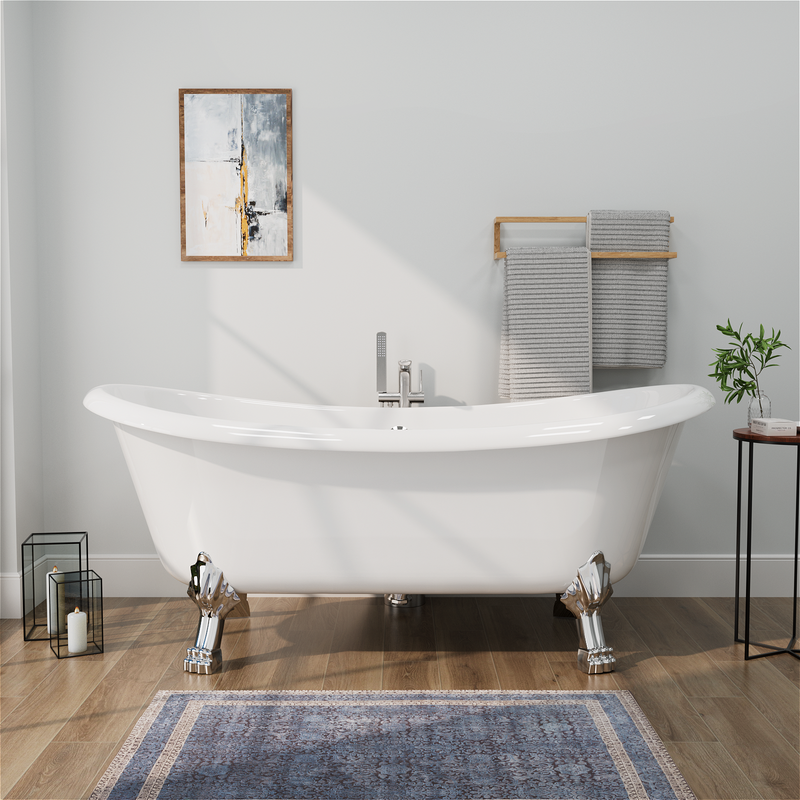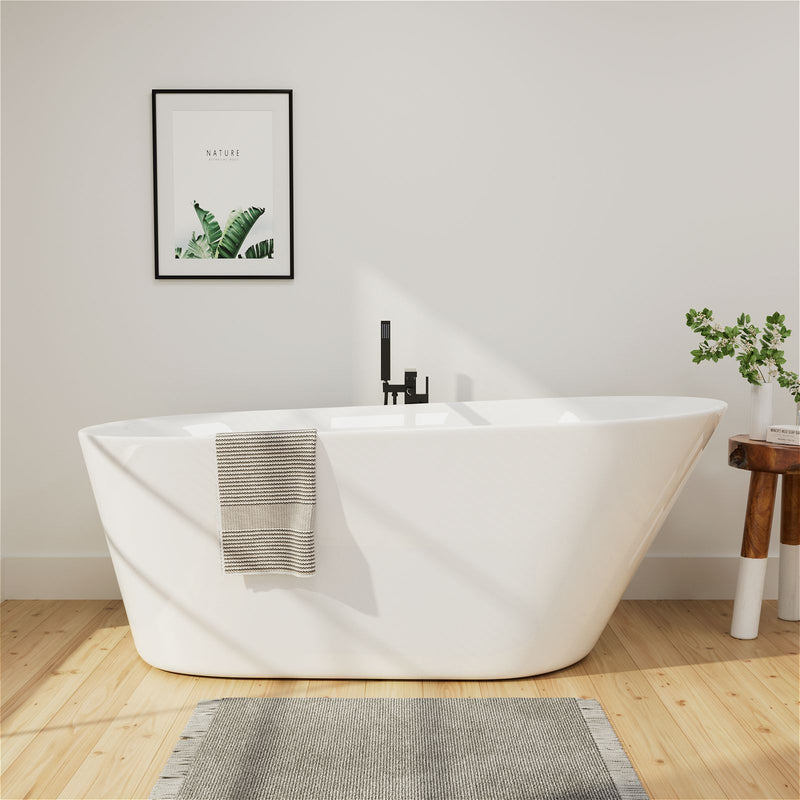In recent years, many American homeowners have shifted their focus from purely utilitarian bathrooms to spaces that support relaxation, wellness, and aesthetic appeal. Among the trending fixtures is the oval soaking bathtub — a design that blends form, function, and a sense of spa-like indulgence. Unlike standard tubs, soaking bathtubs allow deeper immersion. The oval shape, in particular, adds ergonomic comfort, visual appeal, and flexibility in layout.
In this article, we explore in detail the advantages, design and material considerations, installation challenges, maintenance strategies, and selection guidance for oval soaking tubs.
What Defines an Oval Soaking Bathtub?
Depth and Immersion vs. Traditional Tubs
A soaking tub differs from a conventional bathtub primarily in water depth: it allows for full or nearly full submersion of the body. Whereas traditional tubs might provide about 12–18 inches of water, soaking tubs frequently exceed that, sometimes reaching depths of 20–24 inches or more, depending on design.

Because of that greater depth, a soaking tub allows someone to sit upright and still have water cover much of the torso, rather than just the legs or hips.
The oval soaking tub is simply a soaking tub whose footprint is an oval shape. The curved edges reduce corners, often make it more ergonomic, and blend more naturally into free-standing or open spaces.
Ergonomics and Visual Flow
Oval soaking tubs are prized for their smooth lines. The absence of sharp right angles means less pressure on shoulders or elbows when reclining. Soft curves also help the visual flow in a bathroom, reducing harsh transitions. Many designers consider the oval form more alive and organic, which appeals to modern and transitional styles.
Additionally, some oval soaking tubs incorporate gentle back slopes or ergonomic contours that support a relaxed sitting posture. These designs encourage a more comfortable soak rather than forcing a rigid position.
Variants: Flat-bottom, Slipper, and Japanese-Style
Within oval soaking tubs, there are subtypes:
- Flat-bottom oval soaking tub: The floor of the tub is level, making it easy to stand or move around.
- Slipper style: One end of the oval is elevated or sloped, allowing a reclined position.
- Japanese-style or deep ofuro version: Though many Japanese soaking tubs are more vertical (to sit upright), some are oval deep tubs allowing greater depth and compact footprint.
Each variation affects comfort, entry, and visual presence, so it's vital to match style to your needs.
Why Choose an Oval Soaking Bathtub? Key Benefits
Deeper Immersion & Better Heat Retention
Because the water depth is greater, less water surface is exposed per unit of volume, meaning less heat is lost. In effect, an oval soaking tub holds warmth better than a shallow standard tub.
Also, the oval form often has fewer sharp corners where heat can escape faster. This means your bath stays comfortable longer, reducing the need to add hot water frequently.
There is a research-based model of temperature distribution in a tub that suggests the geometry of a bathtub — including rounded corners — influences heat loss. For example, in modeling a tub's temperature drop over time, researchers found that curved boundaries can moderate heat loss compared to sharp corners.
Enhanced Comfort & Ergonomics
The curved walls of an oval tub align more naturally with the human body's contours. The lack of hard corners reduces awkward contact, especially when reclining or shifting. The soft slopes on many models support the back and neck more gently than a simpler rectangular tub.
Because of this, many bathers find they can soak longer with less fatigue or discomfort, which enhances the relaxation experience.
Space Efficiency in Length
One lesser-known advantage is that a deeper tub can sometimes be shorter in length while still offering full immersion. In some cases, a deep oval soaking tub may take up less horizontal space than a conventional long tub while still covering more of the body.
This can be a benefit in bathrooms where length is limited but depth is acceptable. You gain immersion without overshooting your available linear space.
Aesthetic Appeal & Focal Point
Oval soaking bathtubs often serve as a centerpiece. Freestanding oval tubs float in space, giving an architectural and sculptural quality to a bathroom. That creates a focal point, especially when paired with good lighting, tile accents, or interesting plumbing fixtures.
This can increase perceived value—many remodels place bathtubs as a spa-like anchor that elevates the entire bathroom aesthetic.

Health, Wellness & Relaxation
Soaking in warm water has been associated with many wellness benefits. Some documented or commonly cited effects include:
- Muscle relaxation and joint relief: Warm water soothes stiff joints, reduces muscle tension, and increases circulation.
- Stress reduction and mood enhancement: Immersion in warm water can lower cortisol levels, promote endorphin release, and help stabilize mood.
- Improved sleep: A soak before bedtime can lower core body temperature afterward, promoting sleepiness. Some bathing guides and studies note this as a benefit.
- Circulation and cardiovascular effect: The hydrostatic pressure from immersion helps circulation and can reduce swelling.
- Skin cleaning and hydration: A soak helps soften and remove dead skin cells; when combined with bath oils or mild salts, it can promote hydration.
Because oval soaking tubs allow deeper immersion, you may attain these benefits more fully than in shallower tubs.
Design and Material Choices: What to Watch For
Material Options & Trade-offs
The choice of material is critical: it affects heat retention, durability, weight, cost, and maintenance. Common materials include:
- Acrylic: Lightweight, versatile in shape, and relatively affordable. Its drawback is that it doesn't retain heat as well as heavier materials.
- Enameled cast iron: Excellent heat retention and durability, but very heavy and challenging to install.
- Stone resin / solid surface: A modern favorite that blends some of the thermal benefits of solid material with more flexibility and aesthetics.
- Natural stone: Highly luxurious and durable, but extremely heavy, expensive, and may require custom structural reinforcement.
- Wood (rare in U.S. mainstream): Occasionally used in high-end or niche designs (inspired by Japanese ofuro designs). It requires intensive maintenance to avoid water damage.
When choosing, consider not just visual appeal but structural load, heat retention, cost, repairability, and upkeep.
Dimensions and Proportions
Important dimension factors include:
- Length and Width: Decide based on your bathroom footprint and how many people may use the tub simultaneously.
- Depth (soaking depth): A deeper tub gives more immersion; aim for at least 18–20 inches for a genuine soaking feel.
- Wall thickness and structural support: Materials with thicker walls retain heat better but weigh more. Ensure floor support is adequate.
- Drain and overflow location: These affect plumbing layout and ease of maintenance.
Shape Variants & Ergonomics
As mentioned earlier, design variants (flat-floor, sloped, ergonomic contours) affect comfort. When possible, sit in or test a mock-up. Make sure the tub shape supports the posture you expect to use (reclined, upright, semi-reclined).
Structural & Floor Load Considerations
Because soaking tubs hold significantly more water than normal tubs (and themselves often weigh more), the floor structure must handle the load. 1 gallon of water weighs about 8.34 lbs, so a tub holding 60–80 gallons adds 500+ lbs. Add the weight of the tub itself and occupant(s). Consult a structural engineer or experienced installer if your floor joists or subfloor are uncertain.
Plumbing and Heater Capacity
Since soaking tubs draw more water volume and often maintain high temperature for longer, evaluate:
- Water heater capacity: Can your heater handle filling a deep tub?
- Flow rate and plumbing size: Larger drains and supply lines may be needed.
- Overflow and drain design: To prevent splash-out and flooding.
- Access panels: For maintenance.
Finishes, Coatings, and Accessories
Choose durable, nonporous finishes for easy cleaning. Look for scratch-resistant coatings. Plan for accessories like built-in grab bars, feet or pedestals, neck pillows, or integrated steps, especially in deeper tubs.
Installation & Practical Challenges
Delivery and Placement
Because oval soaking tubs are often large, heavy, and awkward, getting them into your bathroom can be challenging. Watch for:
- Stairwells, door widths, tight corridors.
- Need for scaffolding or removal of walls.
- Support for lifting the tub into place.
Many installers pre-place the tub before finishing flooring or trim to avoid damage.
Flooring & Waterproofing
Proper waterproofing is essential. Surrounding tile, underlayment, and any transitions must be sealed to prevent water ingress. Also, consider floor finishes that resist water and provide some grip when exiting the tub.
Plumbing Connection & Sealing
Ensure all plumbing connections are sealed correctly (drain, overflow, faucet, supply). Use flexible connectors where possible to accommodate slight shifting. Check for leaks after installation.
Structural Reinforcement
If the tub is over a wood-joist floor, you may need to reinforce with additional blocking, sistered joists, or a load-bearing platform. In concrete slab situations, ensure the slab is rated for the combined weight.
Testing and Filling
Before finishing, fill the tub to test for leaks and verify that drains and overflows work correctly. Also monitor how quickly water cools—this gives you a preview of your insulation/heat retention performance.
Maintenance, Cleaning & Longevity
Regular Cleaning Habits
- Use mild, nonabrasive cleaners. Avoid harsh chemicals or scouring pads that might scratch surfaces.
- Rinse after each use to remove soap residue or salts.
- Wipe downs of exposed surfaces help prevent mineral deposits.
Tackling Hard Water & Mineral Build-Up
If your area has hard water, scale can accumulate on surfaces and drains. Use mild acid-based descalers or vinegar solutions periodically, following manufacturer guidance.
Inspection & Seal Check-ups
Periodically check seals around drains and overflow, re-tighten fittings, and monitor for leaks. Over time, some seals or gaskets may need replacement.
Resurfacing or Restoration
High-end tubs (stone resin, acrylic, etc.) may allow refinishing or resurfacing if scratches or wear occur. Check with the manufacturer—many offer repair kits or services.
Energy & Water Conservation
Since deep tubs use a lot of water, consider:
- Filling only as deep as needed.
- Using bath covers to retain heat.
- Upgrading to high-efficiency water heaters.
- Installing low-flow fill valves to reduce waste.
Modern models are becoming more efficient, helping offset the increased water usage.
How to Choose the Right Oval Soaking Bathtub
Understand Your Priorities & Constraints

Ask these questions:
- Do you prioritize depth and immersion over length?
- What is your budget range (including plumbing and reinforcement)?
- Can your floor support the combined weight?
- Is your water heater capable of filling the tub adequately?
- How often will the tub be used, and by whom (e.g., seniors, children)?
- What style aesthetic do you want (modern, classic, spa)?
Test Before Committing
Whenever possible, visit showrooms and sit or recline in different tubs. Feel the slope, check comfort, and get a sense for how depth feels.
Match Dimensions to Space
Draw your bathroom plan with accurate dimensions, including clearance for doors, fixtures, and movement around the tub. Leave buffer zones for maintenance, cleaning, and use.
Factor in Installation & Hidden Costs
Always include possible expenses for structural reinforcement, plumbing rerouting, delivery, and labor. These can add significantly to the purchase cost.
Plan for Maintenance & Longevity
Prefer materials with good heat retention, scratch resistance, and refurbishing potential. Ask the manufacturer about warranties, repair services, and recommended care.
Mind the Aesthetics & Accessory Integration
Select faucets, drains, overflow styles, and finishes that harmonize with your bathroom décor. Ensure compatibility with wall, floor, or ceiling-mount plumbing.
FAQs
Q1: What is the ideal soaking depth for an oval soaking bathtub?
A: A good soaking tub typically offers at least 18 to 20 inches of immersion depth, allowing the water to cover a seated bather's torso. Many premium models exceed 22 inches.
Q2: Do oval soaking tubs use more water than standard tubs?
A: Yes, due to deeper fill levels, soaking tubs require more water volume. However, because of improved heat retention and efficient shapes, the energy cost doesn't scale linearly with water use.
Q3: Are soaking tubs harder to install?
A: They can be more demanding due to weight, water volume, and structural needs. Careful planning, floor reinforcement, and plumbing adjustments are often needed. But the basic plumbing is similar to regular tubs, so many skilled installers can manage the job.
Q4: What material should I choose for durability and heat retention?
A: For optimal balance, stone resin or solid surface materials often outperform acrylic in heat retention while being lighter than stone. Cast iron is excellent for heat but heavy to install. Natural stone offers luxury but demands high structural support.
Q5: Can children or elderly people safely use deep soaking tubs?
A: Caution is needed. The depth can pose a risk to small children unless supervision or safety features (e.g. built-in seat, handles or steps) are added. For seniors or mobility-limited individuals, consider tubs with lower thresholds, seating, or assistive handles.
Q6: How long does the water stay warm in a soaking tub?
A: That depends on material, water surface area, ambient temperature, and insulation. A well-designed tub with rounded corners and minimal surface exposure retains warmth longer. A mathematical model suggests that under favorable geometry, heat loss slows after initial minutes.
Q7: Is an oval soaking tub a good resale investment?
A: Frequently, yes. Spa-style bathrooms are attractive to many buyers. Since many remodelers now prefer soaking bathtubs (71% of tub replacements, per Houzz data), a high-quality oval soaking tub can elevate the perceived value of your bathroom.
Q8: How do I maintain and clean a soaking bathtub?
A: Use mild, nonabrasive cleaners. Rinse after each use. Remove scale buildup periodically using gentle descalers. Check seals and plumbing annually. High-end tubs may be resurfaced if needed.
Conclusion
An oval soaking bathtub represents more than just a functional fixture—it can transform your bathroom into a retreat, offering immersion, comfort, visual elegance, and wellness benefits. While the deeper design demands careful consideration of structure, plumbing, and materials, the payoff can be significant: a more relaxing bath, a design focal point, and a premium feature for your home.
If you choose wisely—balancing depth, footprint, material, and support—you can enjoy decades of nightly respite in a tub that doesn't just serve utility, but enhances your quality of life.

